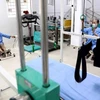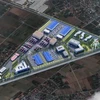Nearly 40 percent of provincial satellite hospitals have reported a decrease in the number of patients being transferred to higher-level hospitals for treatment, helping to lift the burden on central hospitals that has been weighing them down for decades.
The figure was released at a conference on the development of satellite hospitals held by the Ministry of Health in Hanoi on July 24.
Representatives of more than 30 central and satellite hospitals together with health officials and city and provincial leaders attended the one-day conference to discuss solutions to the obstacles satellite hospital development is facing.
The project, approved by the Ministry of Health in 2013, aims to reduce overloading at big hospitals.
In the first stage of the project, 14 central hospitals were chosen by the Ministry of Health as ‘core hospitals' responsible for transferring advanced medical techniques to 46 satellite hospitals across 38 provinces and cities in Vietnam.
The technical transfer focuses on cardiology, oncology, exterior injuries, obstetrics and paediatrics.
The transfer rate to higher-level hospitals of patients suffering from brain trauma at Ninh Thuan Provincial Hospital, one of the satellite hospitals chosen for the project, reduced dramatically by about 88 percent, from 104 cases in 2013 to 12 last year.
Phu Tho Provincial Hospital said that the number of patients that underwent radiation treatment and tumor removal surgery at the hospital rose from 2875 cases in 2013 to 5535 a year later. This was thanks to the excellent technical transfer from central hospitals, said Minister of Health Nguyen Thi Kim Tien.
The Ministry would speed up technical transfers and expand the network of satellite hospitals to all provinces in the country, she said.
"The Ministry will also invest more in the infrastructure of ‘core hospitals' to further facilitate training and technical transfer in lower-level hospitals," she said.
Telemedicine, in which telecommunications is used to provide remote healthcare, will also be applied in training and used for joint medical consultations between central and provincial hospitals, she said.-VNA
The figure was released at a conference on the development of satellite hospitals held by the Ministry of Health in Hanoi on July 24.
Representatives of more than 30 central and satellite hospitals together with health officials and city and provincial leaders attended the one-day conference to discuss solutions to the obstacles satellite hospital development is facing.
The project, approved by the Ministry of Health in 2013, aims to reduce overloading at big hospitals.
In the first stage of the project, 14 central hospitals were chosen by the Ministry of Health as ‘core hospitals' responsible for transferring advanced medical techniques to 46 satellite hospitals across 38 provinces and cities in Vietnam.
The technical transfer focuses on cardiology, oncology, exterior injuries, obstetrics and paediatrics.
The transfer rate to higher-level hospitals of patients suffering from brain trauma at Ninh Thuan Provincial Hospital, one of the satellite hospitals chosen for the project, reduced dramatically by about 88 percent, from 104 cases in 2013 to 12 last year.
Phu Tho Provincial Hospital said that the number of patients that underwent radiation treatment and tumor removal surgery at the hospital rose from 2875 cases in 2013 to 5535 a year later. This was thanks to the excellent technical transfer from central hospitals, said Minister of Health Nguyen Thi Kim Tien.
The Ministry would speed up technical transfers and expand the network of satellite hospitals to all provinces in the country, she said.
"The Ministry will also invest more in the infrastructure of ‘core hospitals' to further facilitate training and technical transfer in lower-level hospitals," she said.
Telemedicine, in which telecommunications is used to provide remote healthcare, will also be applied in training and used for joint medical consultations between central and provincial hospitals, she said.-VNA



















